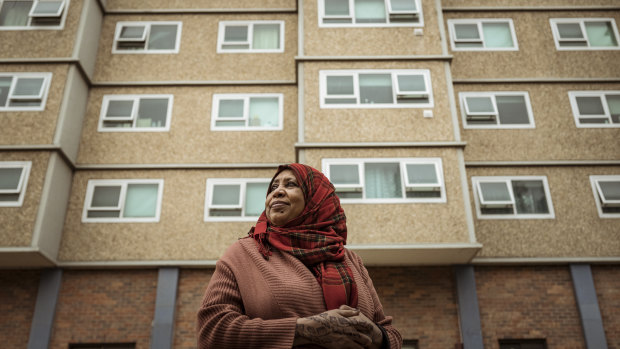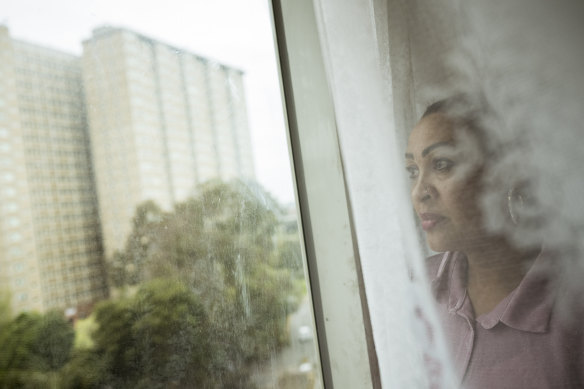By Rachael Dexter and Cara Waters
Plans to knock down 44 public housing towers will destroy public housing in the state, according to some residents, advocates and community groups, who warn public land is being sold off to private developers.
The towers have been landmarks on Melbourne’s skyline for more than half a century, but on Wednesday Premier Daniel Andrews announced they would be pulled down and redeveloped over the next three decades.
The government billed its plans for a public-private partnership as “Australia’s biggest ever urban renewal project”. It is one part of a major housing statement issued to tackle the state’s housing crisis.
“Our 44 high-rise towers are old; they’re out of date,” Andrews said. “They are crumbling; they need to go.”
The premier said the towers in prime locations including Flemington, Fitzroy and North Melbourne housed 10,000 public housing residents between them, but after all sites were redeveloped 30,000 people would be housed.
However, only 11,000 of the 30,000 would be public tenants, he said, with about 19,000 other residents “in a mixture of social and market housing”. In March there were about 58,000 households on Victoria’s public housing waiting list.
“The parcels of land are much bigger than what’s currently got buildings on it,” Andrews said. “There is room there and height to do so much more. So we think this is a unique partnership opportunity with super funds, with the private sector.”
The towers in Racecourse Road, Flemington, among the first slated to be knocked down, are due to go by 2031, and residents were told of the news on Wednesday by a Homes Victoria team, which handed out leaflets along with chocolates and biscuits.
Sarah, who did not want to give her full name, has lived on the Flemington estate for 15 years and said she did not want to move.
“If they cared about us, they wouldn’t move us,” she said. “It’s all rubbish. They want to build the houses and put higher rent for rich people. They are moving us from the city.”
But Awatif Taha, who has lived on the estate for 20 years, said the government’s plans could improve conditions for residents.

Resident Awatif Taha outside one of the Racecourse Road, Flemington, towers.Credit: Chris Hopkins
“I’m happy about this decision and the reason why is these buildings are too old,” she said. “I think the government is going to do the right thing. They are not going to destroy these buildings without reason. Of course they have reasons, but we ask them to put people in the right place.”
Taha said she and other residents wanted to ensure they were able to move back to the same area and back into public housing.
“We need to know after they are going to build this one what are they going to do. Are they going to bring these people back? Is it going to be private? This is our question.”
Melbourne’s prefabricated public housing towers largely replaced slums in the inner suburbs. Built from the 1950s to the 1970s, they were heralded as a major postwar social reform.
Public Housing Residents Network and Save Public Housing Collective spokesman Cory Memery said the announcement had sent shockwaves through public tower communities.
“A lot of people who live in the towers, it’s the only place they’ve ever lived when they came here,” he said. “That displacement is going to be terrifying – there’s a lot of people out there who will be shitting themselves today.”
Louisa Bassini, acting director of legal practice at community legal service Inner Melbourne Community Legal, said the move represented “the wholesale destruction of public housing in this state”.
“We don’t think the case has been made as to why the towers have not been converted. Instead the government is treating the estates as prime land without consideration of the destruction of the communities that is going to ensue,” she said.
Bassini said the towers were only in disrepair because the government had failed to invest in them and that her organisation would call for a reversal of the decision.
“It is the transfer of publicly owned housing stock into the hands of private developers,” she said. “It is a process of gentrification of the inner city and destruction of these communities.”
Victorian Public Tenants Association chief executive Katelyn Butterss pointed to a lack of clarity in the housing statement document over whether the 10,000 displaced public tenants at the sites would remain as public housing tenants or be more expensive community housing tenants.
“Ensuring these new high-rises are public owned and publicly managed is absolutely imperative,” she said.
The Council to Homeless Persons slammed the long-awaited housing statement as a missed “critical opportunity to tackle the most serious housing crisis in living memory”, saying that “behind the big headline numbers, there’s crumbs for social housing”.
“We need at least 60,000 new public and community homes to be built in Victoria over a decade. Unfortunately there’s nothing like that in these announcements,” said council chief executive Deborah Di Natale.
University of Melbourne urban geographer Dr Kate Shaw, a long-term critic of the entrance of private interests into public housing in Victoria, said previous redevelopments of low-rise public housing had shown many residents never returned and that the latest move was a resurrection of a plan by Jeff Kennett in the 1990s to redevelop public housing towers.
The premier said on Wednesday that vulnerable tenants in the towers had been door-knocked on Wednesday morning to be told of the plans.
“We will treat those residents ... with the utmost respect,” he said. “And it’s not just door-knocking this morning ... there’s phone lines, there’ll be people in place ongoing to talk through all those issues and make sure that everybody is supported.
“No one’s having to leave their home tomorrow. It’ll be done in a staged way. It’ll be done thoughtfully, respectfully appropriately.”
Ruth Eyakem has lived in the Flemington towers for more than 20 years and said improvements were desperately needed.
“There is a lot of leaking happening in the building and then asbestos being found on the ground,” she said. “If you are going to move people where they want, it will be very nice. They will be happy.”
Melbourne University architect Chris Barnett, who oversaw research into alternatives to demolishing the towers, said while the buildings were outdated, the “decanting costs” of moving residents out for years during construction before moving them back in would probably run into tens of millions of dollars per tower.

Ruth Eyakem has been a resident of the Racecourse Road housing towers for over 20 years.Credit: Chris Hopkins
“The decanting costs and social disruption alone – gee, you’d really want to have explored any other option than knock-downs,” he said.
Victorian Greens leader Samantha Ratnam said the government had chosen to “privatise two-thirds of the estates” instead of redeveloping the sites entirely for public housing, while state opposition housing spokesman Richard Riordan said, “vulnerable Victorians looking for a place to call home today will find no immediate or achievable solutions in the housing strategy”.
Get the day’s breaking news, entertainment ideas and a long read to enjoy. Sign up to receive our Evening Edition newsletter here.